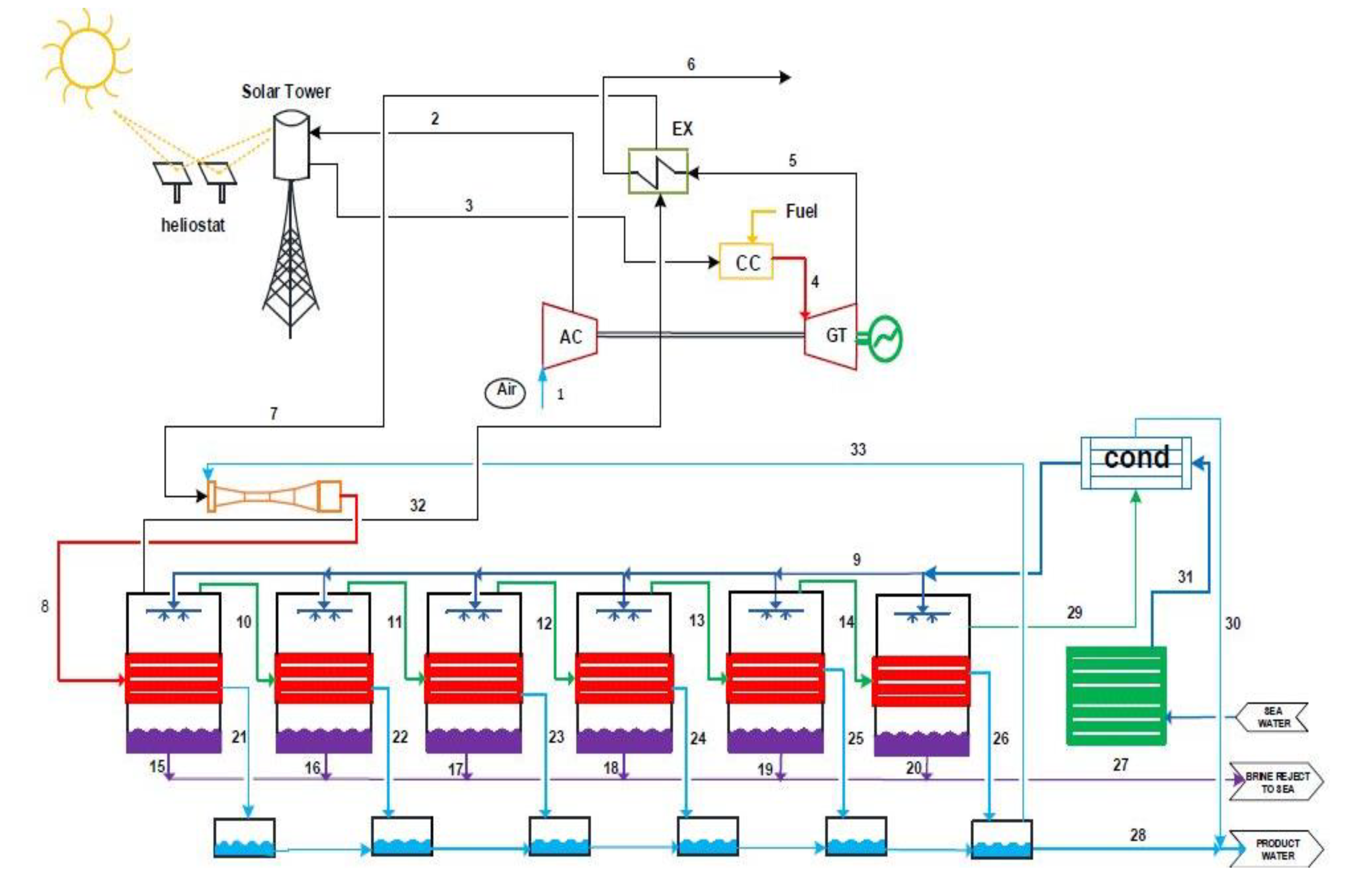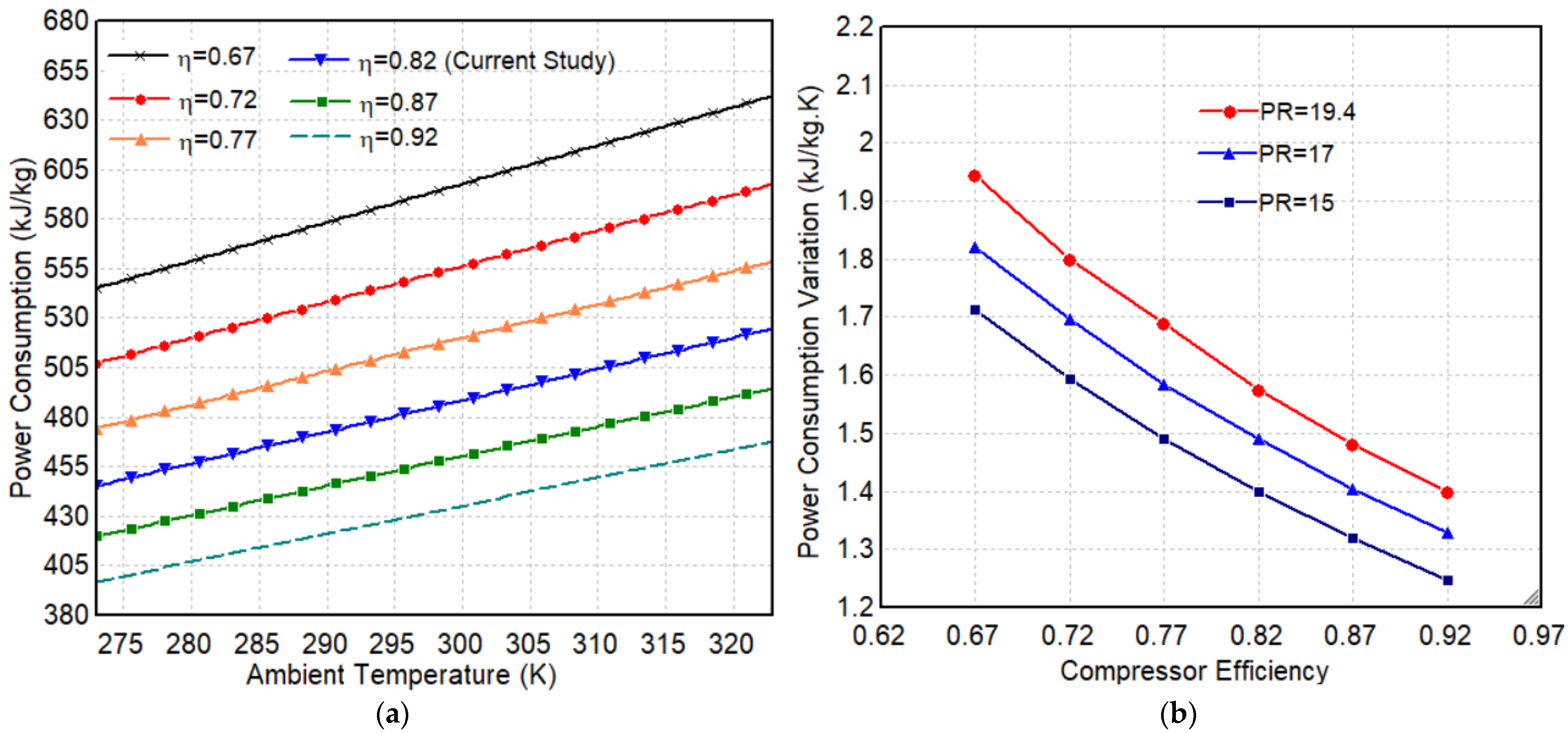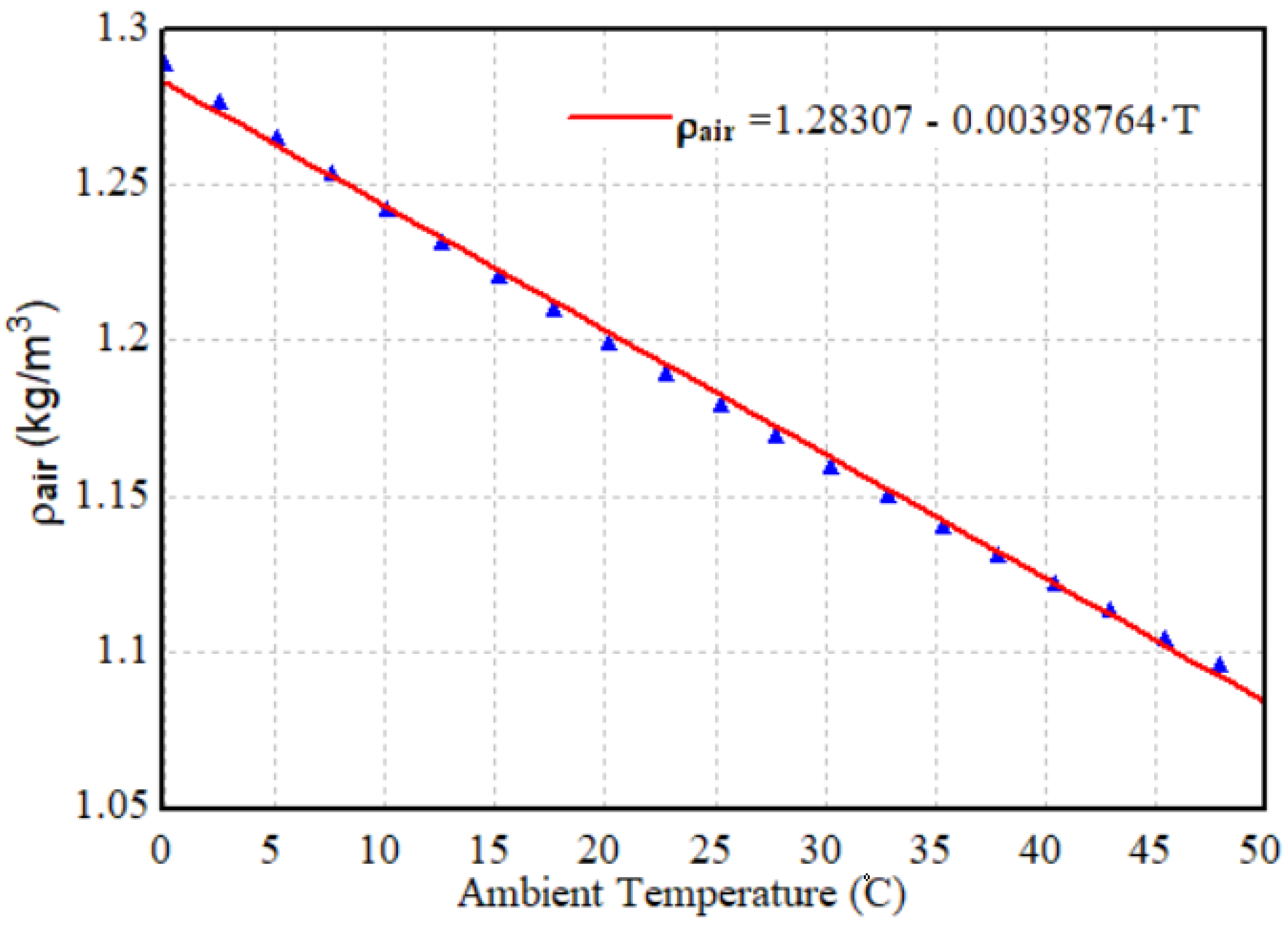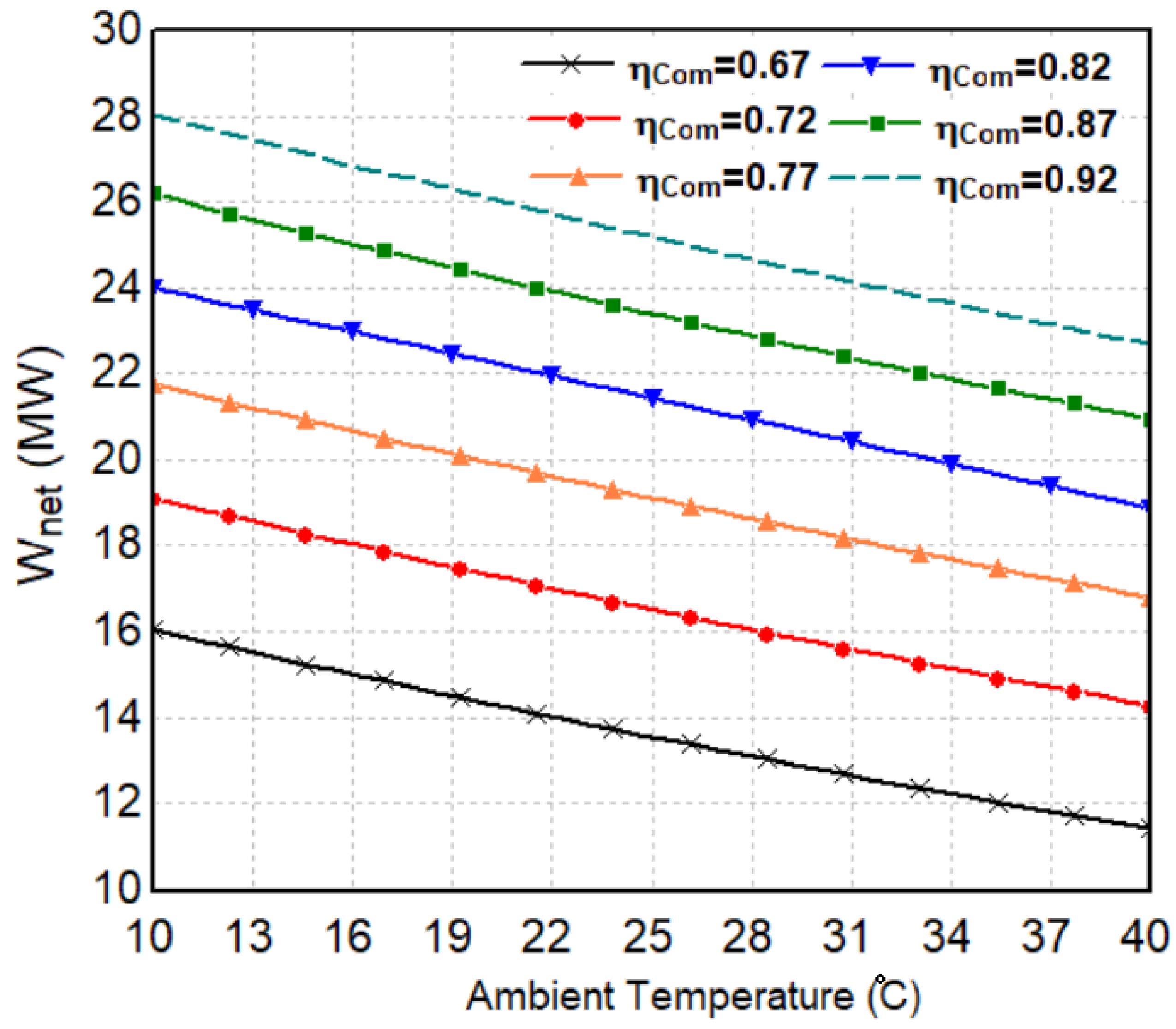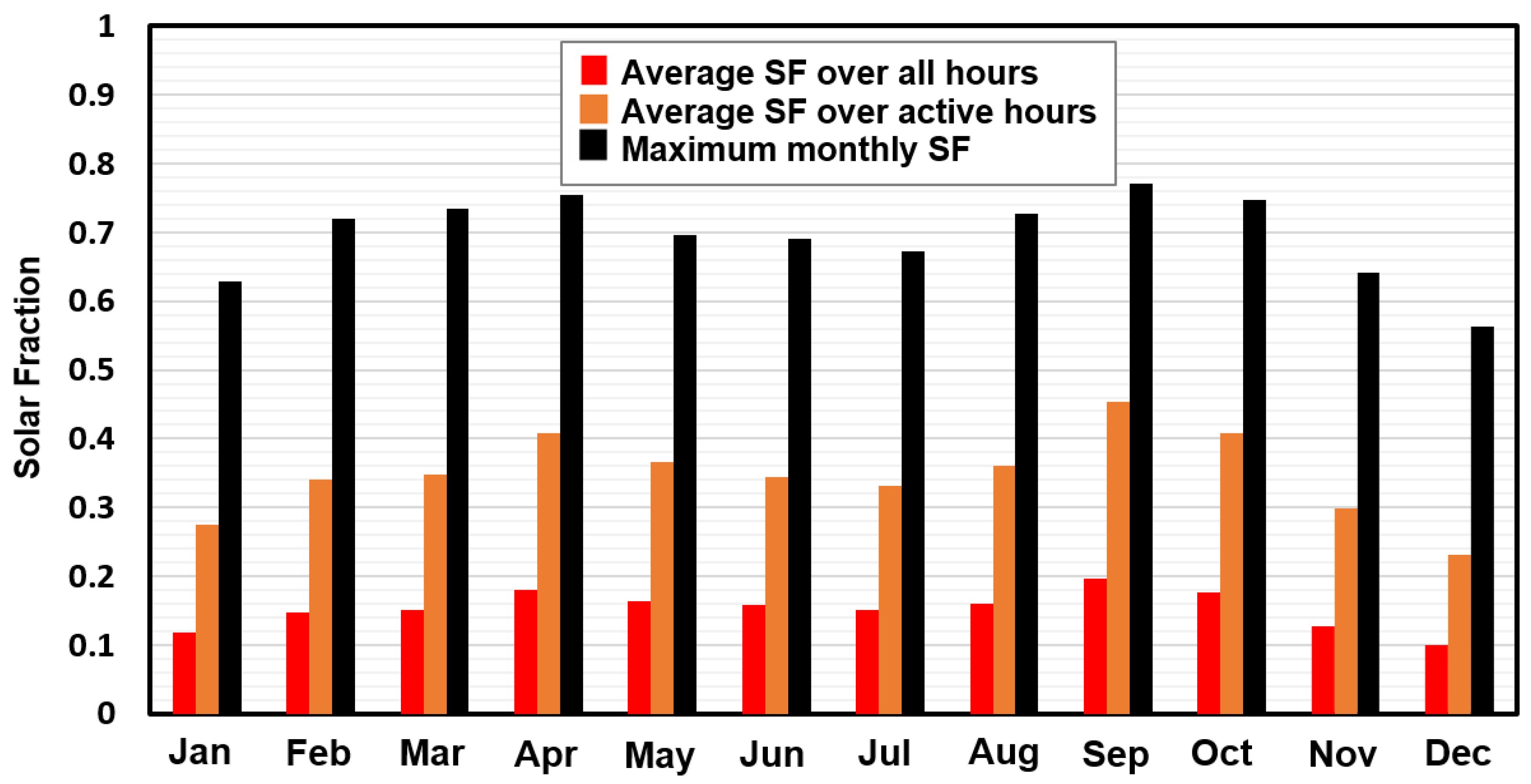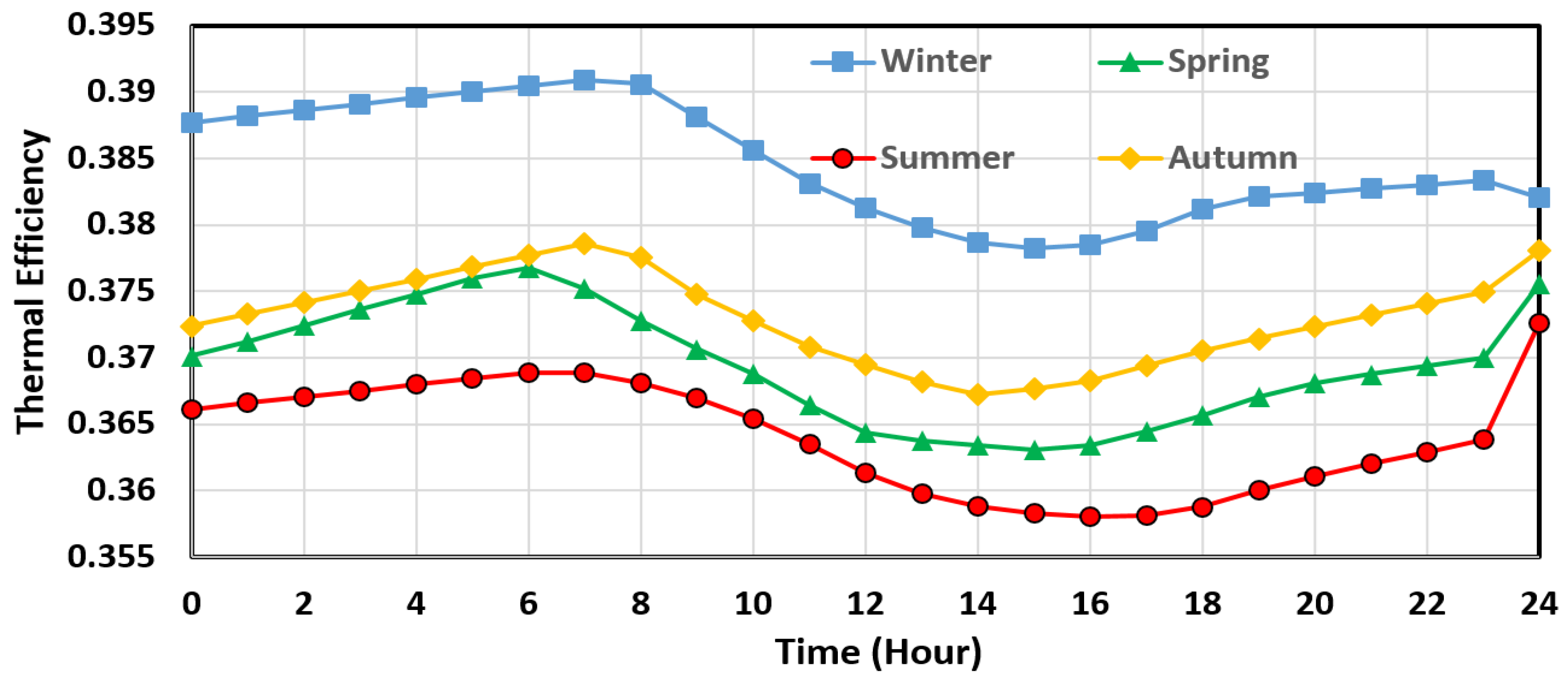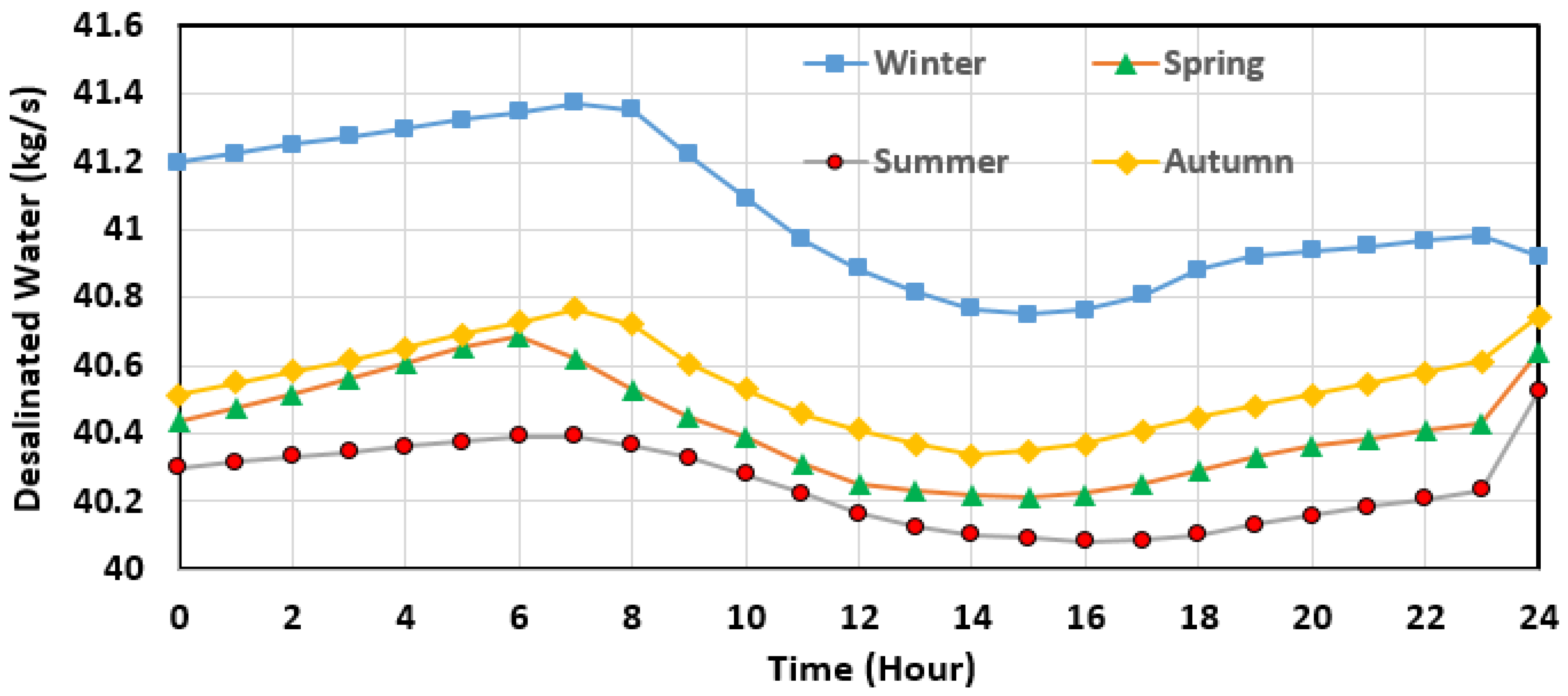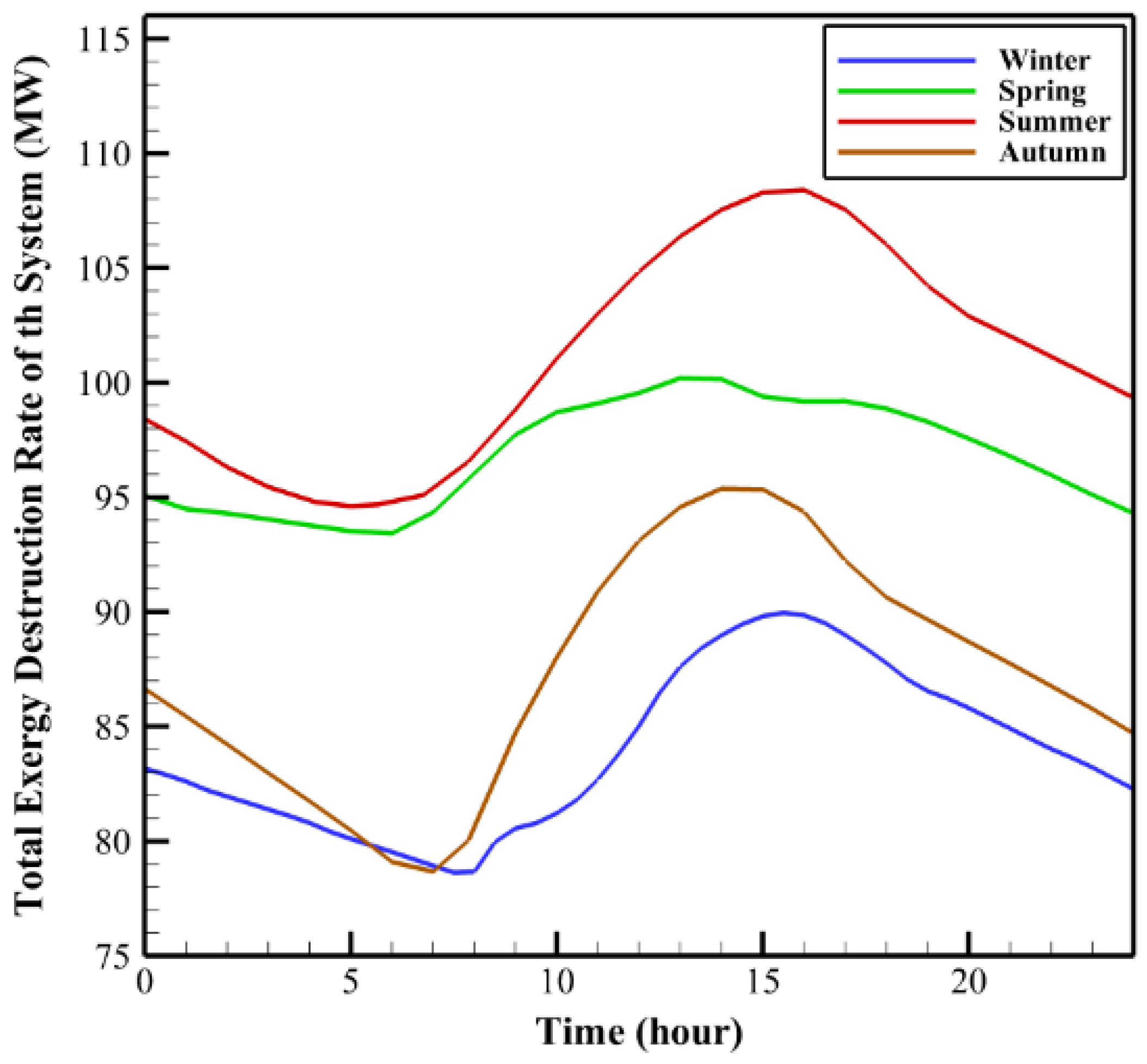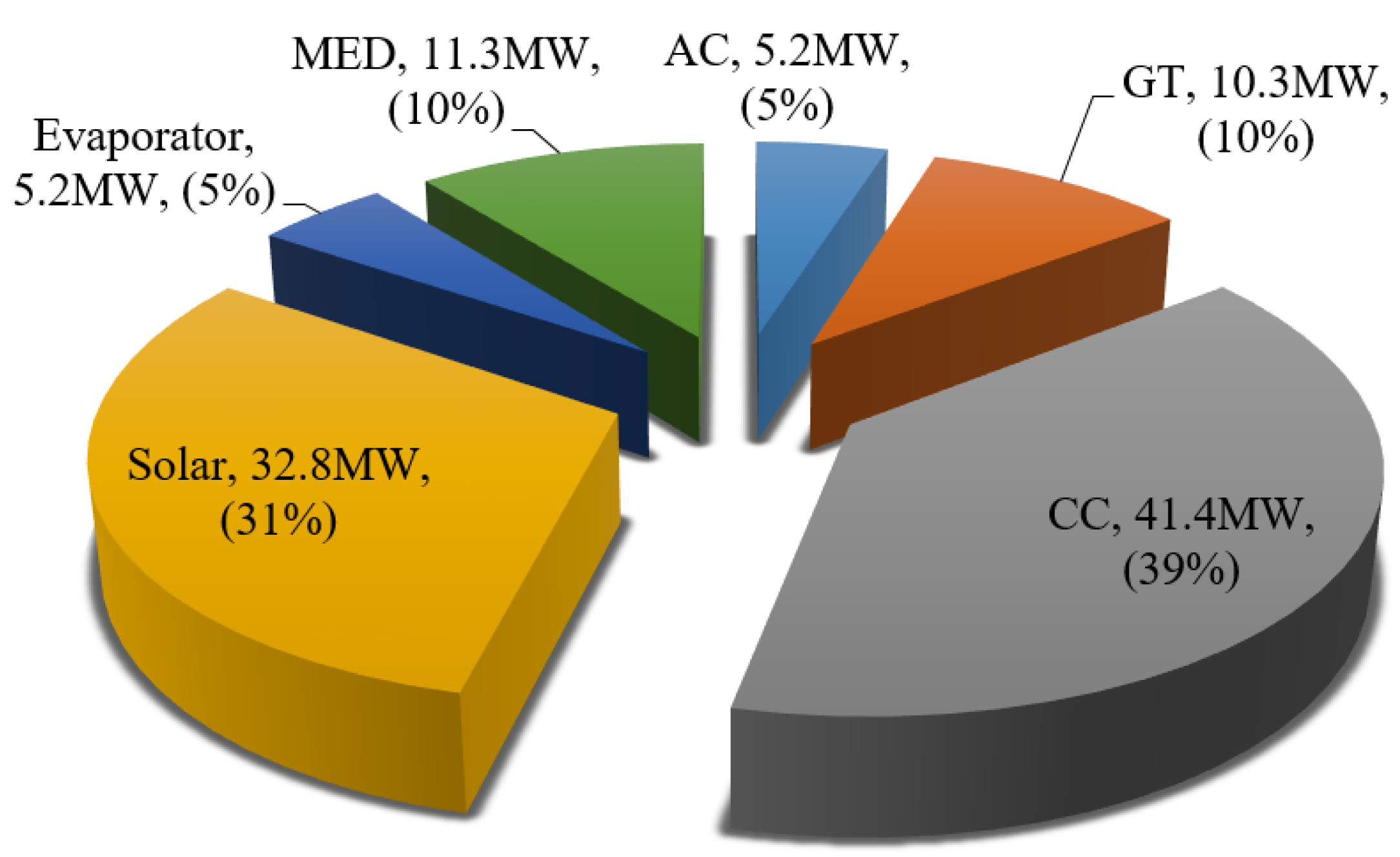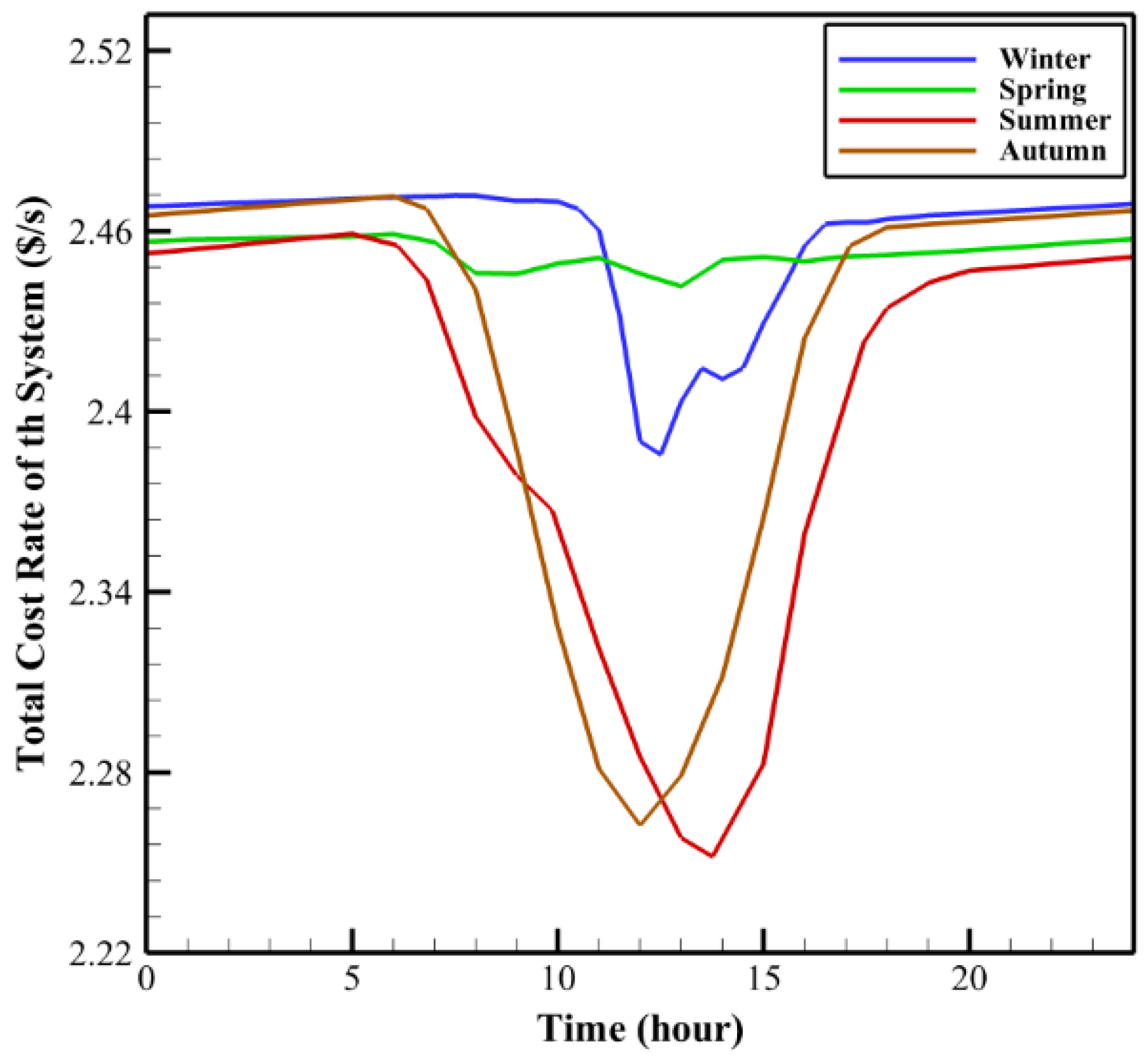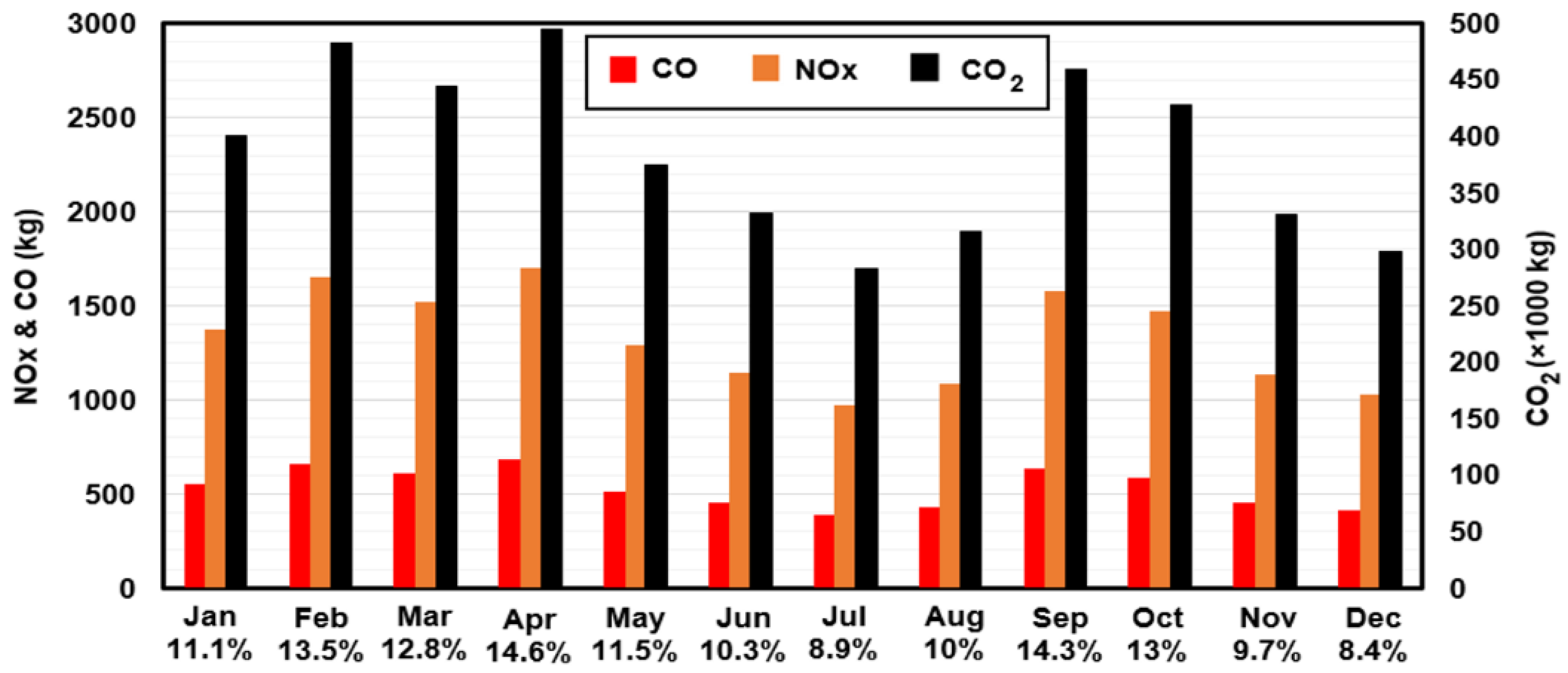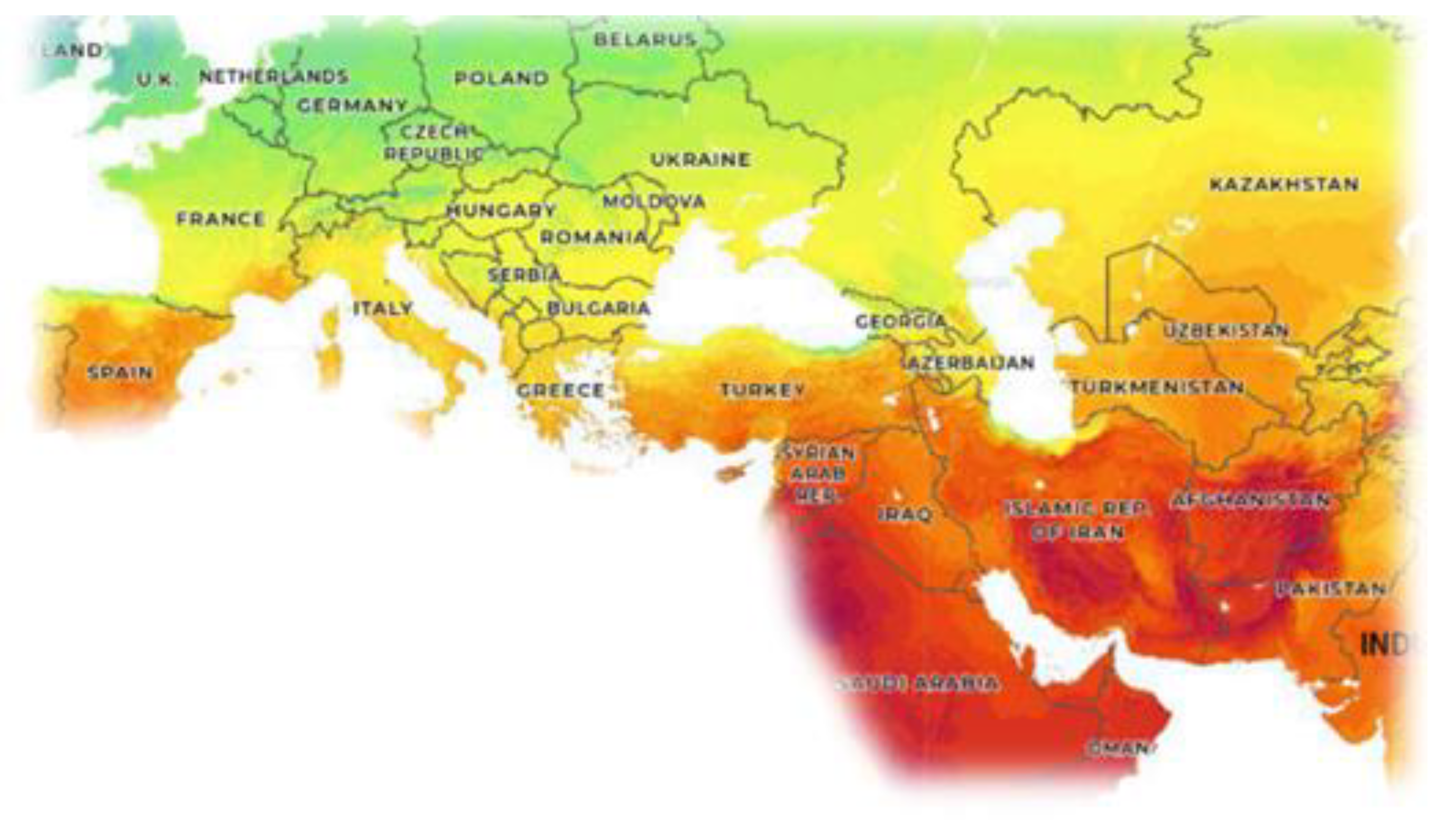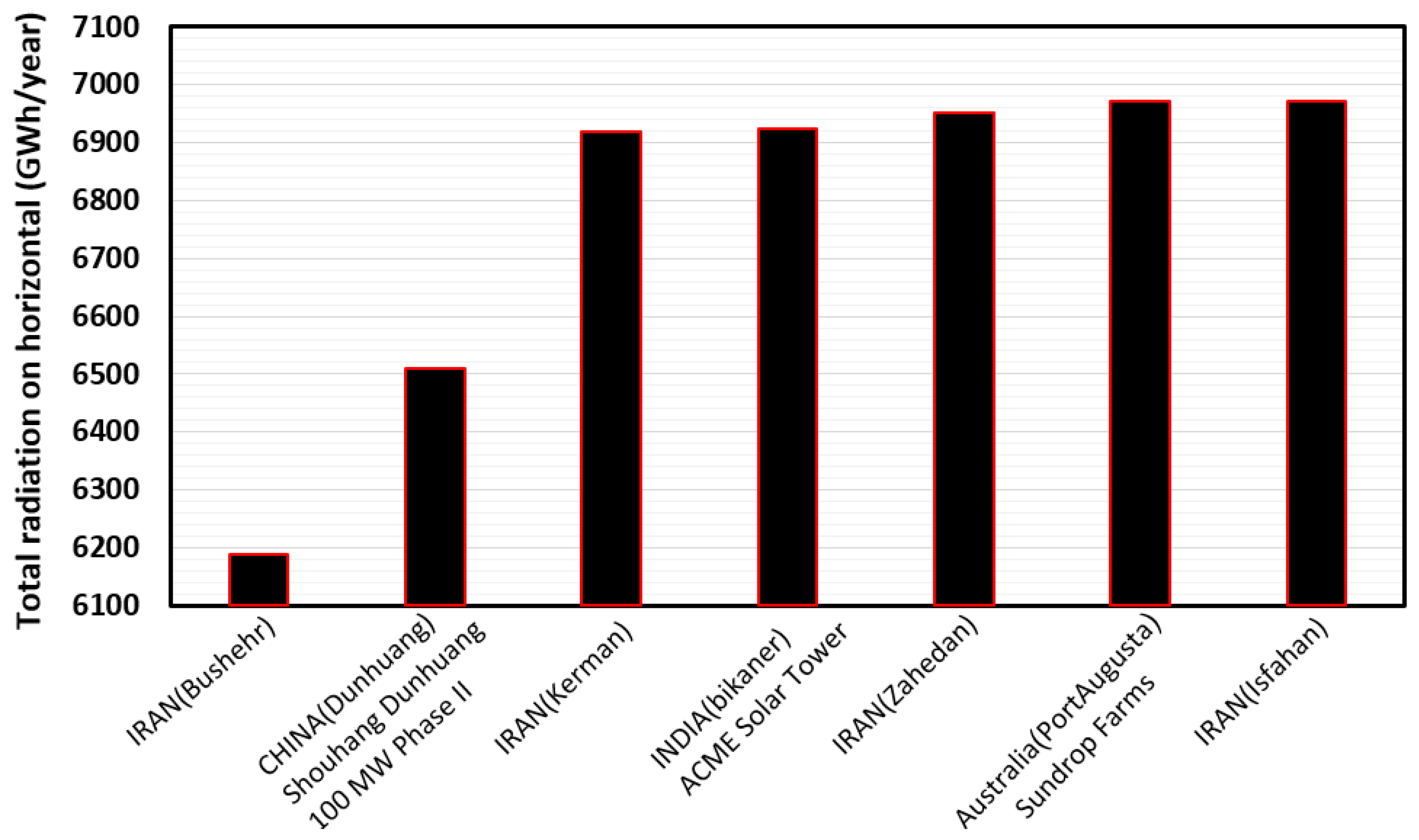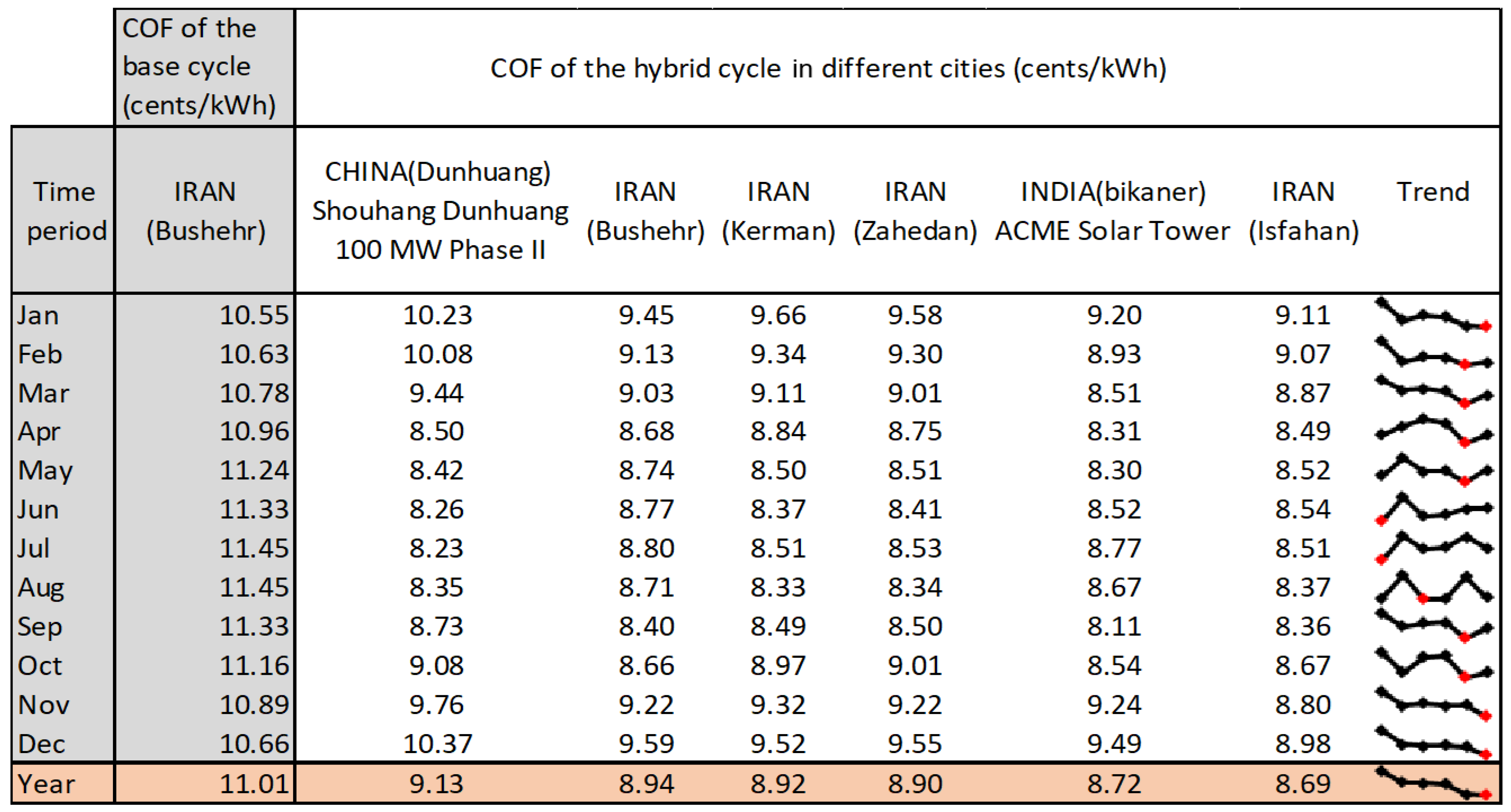1. Introduction
Access to clean water and a reliable source of energy are two essential requirements for human beings. Global water demand is steadily rising and is expected to grow from 4600 in 2016 to 6000 by 2030 [
1]. Additionally, based on statistics reported by UNICEF and the World Health Organization (WHO) in 2023, almost 2.2 billion people do not have access to potable water. Furthermore, the rate of energy consumption is drastically increasing to the extent that primary energy consumption in 2017 was approximately 5.48 times that of 1950 [
2]. As power generation continues to rise, so do the levels of harmful pollutants being emitted. Hence, systems that provide both energy and potable water and simultaneously help to lessen pollutant emissions are considered a superb sustainable solution.
One of the best approaches for desalinating water is utilizing unavoidable waste heat released into the atmosphere at high temperatures. This can be achieved by capturing the exhaust from gas turbines and using it as the heat source for a multiple-effect distillation (MED) process. Some studies [
3,
4,
5,
6,
7] have already evaluated the performance of cycles that include MED with a steam ejector refrigerator (SER) and are fed by waste heat from gas turbines. These articles have examined these cycles from various perspectives and have demonstrated their effectiveness in different ways. Cipollina [
8] proposed a model that addresses most aspects, having limited the formulas of previous models, using used a robust process simulator based on the gPROMS (general PROcess Modelling System) equations to run the system model based on available data from a MED-TVC unit located in Trapani, Sicily (Italy). The outcomes they obtained indicated that such models can effectively depict the system’s dynamic response in relation to all its factors, making it a valuable resource for forecasting temporary operations and designing control systems for MED-TVC facilities. Elsayed, Mohamed L., et al. [
9] presented a detailed analysis of the transient and steady-state performance of a MED-TVC unit. They showed that when the system experiences sudden changes in such parameters as motive steam flow rate, flow rate, and temperature of the cooling seawater, the plant performance is severely affected. These sudden changes lead to a mimicking of the actual conditions that MED-TVC experiences. Both the steady-state and dynamic aspects of the model were validated against experimental data already published. Changes in the brine levels for all disturbances applied were slower than those in flow rates and vapor temperature. Furthermore, changing seawater salinity did not remarkably affect the total production. As to the effective parameters, Hafdhi et al. [
10] focused on an exergoeconomic optimization of a DE-TVC desalination unit integrated with a phosphoric acid power plant. The results demonstrated that the inlet mass flow rate and inlet vapor pressure of the DE-TVC system affirmatively affected the GOR of the system. In their follow-up studies [
11,
12], they thermoeconomically analyzed four configurations of MED-TCV, namely, backward feed (BF), forward feed (FF), parallel feed (PF), and parallel/cross feed (PCF). The effect that ensued from adding a TVC to all configurations was also investigated so that the advantage of the PCF mode could be examined. The results showed that the performance of the PCF configuration was higher than that of other feed configurations; however, having the highest flow rate of the specific cooling seawater was the inevitable consequence of this configuration. The BF configuration had the lowest flow rate. Additionally, changing the input parameters led to the most considerable GOR reduction in the MED-TVC stage compared to other cases, especially in seawater cooling. In another study, You et al. [
13] assessed the performance of a poly-generation system and a MED system integrated with a gas turbine and equipped with a steam ejector refrigerator; the results indicated that using gas turbines with a MED-TVC unit and heat exchangers can be efficient enough to recover exhaust waste heat based on the principle of energy cascade utilization.
In technical terms, there are multiple methods of supplying the necessary energy, including but not limited to geothermal and solar energy. For instance, Kianfard et al. [
14] investigated the performance of a geothermal-based system used to cogenerate hydrogen and distilled water via thermodynamic, exergoeconomic analyses. As another example, Javadi et al. [
15] proposed integrating a MED system, equipped with parabolic solar collectors with the Abadan combined cycle power plant (CCPP) so as to cogenerate power and water. By calculating changes in exergy efficiency, carbon dioxide emission, and the cost of electricity generation which ensued from adding the MED, they evaluated performance enhancement. The obtained results indicated that using the proposed cycle resulted in a 5.3% reduction in CO
2 emissions and allowed the production of 20 million liters of freshwater per day. Some other methods, such as using sewage sludge from a wastewater treatment plant [
16] and even interconnecting the integral pressurized water reactor (iPWRs) to develop nuclear desalination plants (NDPs) [
17], have been proposed.
It is worth mentioning that providing the turbine inlet temperature (TIT) of the gas turbines necessitates a high-temperature heat source; thus, technologies such as heliostats can be helpful to preheat the airflow to near TIT [
18,
19]. Therefore, to reduce pollutant emissions from gas turbines, a concentrated solar power (CSP) system can be used to preheat the incoming flow to the combustion chamber, which, in turn, reduces fuel consumption and emissions. Darwish Ahmad et al. [
20] first modeled the power plant ALQatrana in the Jordan power plant. Afterward, they proposed that the current active cycle could be changed to a hybrid system equipped with CSP. According to the obtained results, the proposed solar system increased power generation by 22.8%, increased productivity by 4.3%, and reduced fuel consumption by 8.4%. Using the proposed system led to a 15% reduction in CO
2 emissions and an annual saving of USD 2.44 million in fuel consumption with a payback period of 5.3 years. Javadi et al. [
21] proposed three different configurations of a solar power tower system to be integrated with the Abadan combined cycle power plant. These proposed configurations included preheating inlet fuel and the inlet air of the combustion chamber. The results showed that the energy and exergy efficiencies of the preheating fuel scenario were 42.56% and 39.42%, respectively. Additionally, applying this scenario reduced emissions by 8041 tons per year. The second scenario, however, seemed to be more beneficial from an economic point of view simply because preheating inlet air and reducing fuel consumption leads to an annual saving of USD 11 million and prevents 34,563 tons of emissions per year.
In order to elevate the solar contribution share, using a low-TIT gas turbine has been suggested [
22]. This is because the lower the TIT is, the less fuel is needed to raise the solar-preheated air temperature up to the TIT. Nevertheless, using low-TIT turbines results in lower thermal efficiency compared to high-TIT ones. Thus, the lower the TIT, the higher the solar share. Needless to say, implementing solar towers to provide the temperature levels required by high-TIT turbines is usually not cost-effective. Some studies [
23,
24,
25] have performed economic and environmental feasibility studies for such systems. Dube Kerme et al. [
26] analyzed a poly-generation cycle equipped with a solar thermal energy system. Three different configurations were evaluated: power generation only, cogeneration power and cooling, cogeneration power and desalination, and a poly-generation system. The results showed that increasing the turbine inlet temperature improved performance, although it also reduced the total exergy destruction.
Although there has been a great deal of attention and research devoted to similar solar cycles, some yet-to-be-addressed points merit consideration. First, the impact of ambient temperature on changing the mass flow rate regarding gas turbine performance is critical, yet has often been overlooked in previous research, while, in a real gas power plant, the mass flow rate of the compressor is not constant. Rather, the volumetric flow rate remains constant. However, few studies, if any, have regarded this variable mass flow rate and its effect on important parameters such as net power, compressor power consumption, efficiency, and even the pressure ratio of the turbine under varying ambient temperatures. Therefore, it is imperative to analyze the cycle under both assumptions to gain a comprehensive understanding of gas turbine performance under different environmental conditions.
Second, some prior studies have examined multi-generation systems, but more studies are needed to dynamically investigate the performance of a MED fed directly by the waste heat of a solar-hybrid gas turbine equipped with a heliostat. Connecting the MED directly to the gas turbines increases the capacity of the MED to desalinate water. In addition, dynamic analysis of the system with a one-hour time step over the year makes it possible to evaluate the system performance in a more realistic, precise manner. Certainly, solar-powered systems can significantly reduce greenhouse gas emissions. To meet all the above requirements, including those of power generation, water desalination, and pollution reduction, a solar-hybrid gas turbine equipped with a MED, SER, and a heliostat is proposed.
In the current research, a hybrid cogeneration cycle including a gas turbine, a heliostat solar field used to preheat the air entering the combustion chamber, and a thermal desalination system to recover the waste heat from the turbine were proposed and quasi-transiently analyzed. In addition to the thermodynamic analysis, the proposed system was also investigated through exergy-economic analysis and calculating the amount of pollutant emissions. Changes in ambient temperature significantly affect the mass flow rate entering the system, and, consequently, system performance experiences remarkable variations. Since the present study considered ambient temperature variations during all hours of the year and repeated the calculations with a time step of one hour throughout the year, sensitivity analyses were performed with two different assumptions, namely, constant volumetric flow rate and constant mass flow rate. In this way, the assumptions considered are as close to reality as possible, and the results obtained from each assumption can be compared.
4. Results and Discussion
Overall, the obtained results are presented in both a daily and a monthly manner. To obtain daily results, four days of each season were determined. These four days were the 15 February, the 16 May, the 16 August, and the 15 November. It should not be left unmentioned that the daily comparisons aimed to understand the parameters’ fluctuations at different hours during the day, whereas monthly results are presented to illustrate the impact of changing environmental conditions throughout the year.
4.1. Thermodynamic Analysis
In a Brayton cycle, ambient temperature (inlet temperature to the compressor) significantly affects the compressor’s power consumption and outlet temperature. Because of the compressor outlet temperature variation, the inlet temperature to the combustion chamber changes, which, in turn, changes the fuel consumption and total turbine inlet mass flow rate; consequently, the output power also changes. Accordingly, this section investigates the effect of ambient temperature variations on the performance of the compressor, combustion chamber, and turbine.
The effects of ambient temperature variations can be investigated by two different assumptions: constant volumetric flow rate and constant mass flow rate. In academic analyses, the mass flow rate is usually assumed to be constant, but this is not the case in the power plant industry. In an actual gas power cycle, the inlet volumetric flow rate is constant, not the inlet mass flow rate. Accordingly, the analyses were performed once with the assumption of constant mass flow and again with the assumption of constant volumetric flow rate. The purpose of the following two sections is to estimate variations in compressor power consumption and power generation due to inlet temperature variation for similar cases with acceptable accuracy, without performing lengthy calculations, whether with a constant mass flow rate or with a constant volumetric flow rate.
4.1.1. Compressor Power Consumption with a Constant Mass Flow Rate
The preliminary simulation results demonstrated that for each degree of increase in compressor inlet temperature, the compressor pressure ratio (PR), determined by the turbine, decreased by approximately 0.36%. Nevertheless, assuming that the mass flow rate to the compressor and the pressure ratio were constant, increasing the ambient temperature, which was the same as the compressor inlet temperature, increased the per-unit mass power required by the compressor.
Figure 2a shows how much the power consumption of different compressors with ambient temperatures increases with a constant PR. To plot all diagrams shown in
Figure 2a, ambient pressure and the PR were assumed to be 1 atm and 19.4, respectively. The amount of increase in compressor power consumption is inversely related to compressor efficiency. Since this relationship is almost linear, the slope of each diagram in
Figure 2a shows the amount of change in the per-unit mass power consumption of the compressor for a one-degree ambient temperature increase. For example, the slope of the blue graph in
Figure 2a is 1.58. That is, in a compressor with a pressure ratio of 19.4 and an efficiency of 0.82, for every degree of ambient temperature increase, the per-unit mass power increases by 1.58 kW. Hence, the points presented in
Figure 2b were obtained by calculating the slope of the shown diagrams in
Figure 2a. To be comparable and more perceivable, all required calculations were repeated with pressure ratios of 15 and 17 (
Figure 2b). The vertical axis in
Figure 2b illustrates the variation in power consumption for different compressors caused by a one-degree change in temperature per kilogram of air supposing, for example, that the inlet mass flow rate and pressure ratio (PR) are constant. PR and the compressor’s efficiency were 15 and 0.77, respectively. In this case, the compressor energy consumption changed by 1.5 (kJ/kg) for every one-degree change in ambient temperature (
Figure 2b).
4.1.2. Compressor Power Consumption with a Constant Volumetric Flow Rate
If the mass flow rate was constant, the ambient temperature increase caused an increase in compressor power consumption per unit mass and reduced power generation. This is because the compressor consumed a portion of the power generation. However, in an actual gas power plant, the trends of the results were otherwise. In actual gas power stations, the inlet volumetric flow rate is constant, not the inlet mass flow rate. When ambient temperature increases, the specific volume of the air goes up, and, in turn, the inlet mass flow rate decreases.
Figure 3 illustrates the effect of temperature on the air density.
Figure 4 shows the compressor power consumption in a gas cycle with variable/constant PR, assuming the inlet volume flow rate is constant. To be simply observed, results related to efficiencies of only 0.87 and 0.82 are presented in this figure. Of course, the results of other efficiency values followed similar trends. The results show that when the volume flow rate and PR were assumed to be constant, increasing the inlet temperature resulted in a slight relative decrease in compressor power consumption, that is, the obtained trend contradicted the results’ trend of the constant mass flow rate.
Accordingly, it can be concluded that in actual conditions where the inlet volume flow rate is constant, if the ambient temperature increases, the amount of compressor power consumption reduction, which is related to the mass flow reduction, overcomes the increase in power consumption per unit mass, as shown in
Figure 2a.
It is worth mentioning that the amount of power consumption reduction, even with a 30-degree temperature increase, is not very remarkable and is small compared to the initial value. However, when considering pressure ratio variations, it does not remain unremarkable (
Figure 4). Equation (28) is an approximate correlation to correctly estimate pressure ratio changes due to temperature variations. This correlation was obtained by performing a sensitivity analysis in Thermoflow software (Ver: 21.0). In this correlation, ∆T indicates inlet temperature variation.
The higher slope of the variable-PR diagrams in
Figure 2 shows that assuming the pressure ratio to be constant in the calculations can cause striking errors.
To clarify, let us assume that the compressor efficiency, as in the present case, is 0.82. In this case, if the PR is considered constant, the compressor energy consumption will decrease by approximately 0.05 kJ/m3 for every degree of temperature increase. On the other hand, if the conditions are similar to those of actual operations (constant volume flow and variable pressure ratio), compressor energy consumption increases by approximately 1.12 kJ/m3 for every degree of temperature increase.
In this regard, similar calculations were repeated for different efficiency values. By doing this, Equation (29) was obtained; this equation made it possible to estimate changes in power consumption in terms of inlet temperature variations with acceptable accuracy in the temperature range of 0 to 50 °C and efficiency range of 0.67 to 0.97. If the inlet air temperature increased (
), the compressor power consumption decreased (
).
Finally, in addition to the following equation, another result indicated that for every 10 °C increase in inlet temperature to the compressor, the compressor power consumption was diminished by approximately 2%.
4.1.3. Turbine Power Assuming Constant Mass and Volume Flow Rates
In this section, an analysis of total turbine power is first presented, assuming a constant mass flow rate. Although the inlet airflow to the combustion chamber was constant, an ambient temperature increase caused the inlet temperature of the combustion chamber to increase. Consequently, the combustion chamber consumed less fuel to supply the TIT, which is constant and unique for every turbine. Thus, an increase in ambient temperature leads to a decrease in the fuel mass flow rate. Additionally, since the turbine inlet mass flow rate was equal to the sum of the air and fuel mass flow rate, it can be concluded that an increase in ambient temperature reduces the turbine mass flow rate and, consequently, total turbine power. However, in fact, the turbine power reduction of the constant volumetric flow is more significant than that of the constant mass flow. This is because if the volumetric flow rate is constant, the ambient temperature increase leads to reduced air mass flow rate and, consequently, fuel mass flow rate. As in this case, both air flow and fuel consumption were reduced, the inlet flow to the turbine was drastically reduced and the total turbine power was reduced more than when using the constant mass flow mode.
The results of the sensitivity analyses performed are schematically presented in
Figure 5. In this schematic, the size of the arrows represents the variations of each parameter compared to other parameters so that the variation trends are perceivable at a glance.
Considering all the points mentioned above, an ambient temperature increase reduced the net turbine power in both constant mass flow and constant volumetric flow.
Figure 6 illustrates the changes in net output power in terms of ambient temperature variations in actual conditions for compressors with different efficiencies.
Figure 6 shows that for every 10-degree increase in ambient temperature, the net output power was reduced by 6 to 9.5%. The amounts 6% and 9.5% are related to the efficiencies of 0.98 and 0.67, respectively. For example, considering an efficiency of 0.82 for the compressor (the present case study), the net output power decreased by approximately 6.8% for every 10-degree increase in ambient temperature. It should be noted that the expressed percentages are not completely accurate and are presented only for rapid, acceptable estimation. Of course, the precise values can be determined from the diagrams (
Figure 6).
In the next step, the proposed cycle was analyzed in the Bushehr city climate throughout the year to calculate the changes in net output power due to ambient temperature variations. The net output power amount was divided by the maximum annual net output power to demonstrate fluctuations in a dimensionless fashion. The simulation time started at noon on 1 January. The left axis in
Figure 7 shows the fluctuations in ambient temperature throughout the year, which was a variable similar to hourly radiation intensity. The lowest ambient temperature during the year was 3.1 °C and the highest temperature was 44.8 °C. The maximum net output power obtained on the coldest day of the year was 25.5 MW, and the minimum net output power was 18.3 MW. This implies that as a consequence of the 41.7 °C increase in the ambient temperature, the net power decreased by 7.2 MW, which is equivalent to 28.3% of the maximum annual net power. After dividing this value by the range of the temperature variation (41.7 °C), it was concluded that net generated power decreases by 0.67% for every one-degree increase in ambient temperature.
4.1.4. Solar Fraction and Thermal Efficiency
The solar system’s energy supply to total energy consumption is called the solar fraction (SF). The equation used to calculate the solar fraction has already been presented in the equations related to the heliostat in
Table 1. In the following section, however, the changes in the solar fraction are compared based on different definitions. The red columns in
Figure 8 show the average monthly solar fraction in different months (the main definition) because since the analyzed cycle lacked an energy storage system, the solar system was deactivated in the absence of the sun, causing average daily solar fraction decreases. The orange columns show the average monthly solar fraction at the hours of the presence of irradiance. Comparing the red and orange columns demonstrates that a heat recovery system can increase the solar fraction even more than two times. The black columns also indicate the maximum solar fraction recorded during each month. As can be observed, in some cases, the proposed solar system could provide up to 77% of the total energy required for the cycle under Bushehr climate conditions.
Figure 9 shows the changes in the solar fraction (equivalent to the red column) during four considered days. As was also predictable, parameter SF increased dramatically during the middle hours of the day and tended to be zero before and after.
Figure 10 shows the efficiency changes at different hours of the day, and the results show that the efficiency of the gas power cycle is inversely related to the ambient temperature. The efficiency was reduced from late at night until before sunrise when the ambient temperature dropped. Then, with the sun rising and the air warming until the middle of the day, a decrease in efficiency was observed that was similar to the changes in net output power during the day.
The above results imply that the cogeneration system had the highest performance in winter and the lowest performance in summer. Additionally, in the middle of the day, there was a relative reduction in the system’s thermal efficiency in all four seasons. In the coldest hour of the year, when the temperature dropped to 3.15, the thermal efficiency went up to 39.11%. In contrast, when the temperature reached 44.8 °C in the hottest hour of the year, the thermal efficiency dropped to 35.26°. Given that the annual average efficiency was 0.372, according to Equation (18), the heat rate (HR) will be equal to 9670.
4.1.5. Fresh Water Production
Although the turbine outlet temperature increased with the ambient temperature, the outlet mass flow rate of the turbine decreased. From a heat transfer point of view, the effect of the mass flow reduction in this process overcame the impact of the turbine outlet temperature increase. As a result, less energy was transferred to the motive fluid in the heat exchanger, consequently decreasing the mass flow rate of the produced freshwater.
Figure 11 illustrates the fluctuations in the mass flow rate of the freshwater produced on four different days of the year. The nominal performance coefficient of the desalination unit was calculated to be 4.1.
Finally, the results showed that freshwater production’s maximum annual mass flow rate was 41.4 kg/s, the annual minimum was 40 kg/s, and the annual average was 40.5 kg/s. As a result, the proposed system could produce approximately 1.2 million cubic meters of freshwater per year under Bushehr climate conditions. In the calculations, the temperature of the water entering the desalination unit was assumed to be 20% lower than the ambient temperature. Therefore, if the inlet water temperature was assumed to be equal to the ambient temperature, the fluctuations in the mass flow rate of the produced water would be slightly lower than those of the current state. Additionally, if the temperature of the water entering the desalination unit was considered equal to a constant number such as 20 °C, the fluctuations in the mass flow rate of the produced water would increase by approximately 2.5 times more than those of the current state. In this case, the produced fresh water’s minimum and maximum mass flow rates would be 39 kg/s and 42.5 kg/s, respectively. Nevertheless, considering the temperature of inlet water as a variable parameter seemed more rational.
4.2. Exergy Analysis
Figure 12 illustrates the exergy destruction rate of the entire system during four days in different seasons. The total exergy destruction rate of the system had the highest value in summer and the lowest value in winter. Additionally, during the day, the rate of total exergy destruction significantly increased in the middle of the day. As a result, it can be concluded that the higher the ambient temperature is, the greater the total exergy destruction rate will be.
Nevertheless, it seems necessary to determine the contribution of the different components to total exergy destruction.
Figure 13 shows a pie diagram of the exergy destruction distribution of each element in the middle of a summer day. The results presented in
Figure 13 show that the exergy destruction rate of the solar system (32.8 MW) contributed approximately 31% of the total exergy destruction and the combustion chamber (CC) had the highest contribution to the total exergy destruction of the system (approximately 39%).
In contrast, the compressor and evaporator had the most minor contributions to the total exergy destruction rate, with approximately 5% (5.2 MW). Overall, it was concluded that the solar system and the components involved in power generation account for the highest portion of total exergy destruction. Therefore, the total exergy destruction rate can be reduced most effectively by focusing on these components and improving their performance.
4.3. Economic Analysis
Figure 14 shows changes in the rate of the total system cost during four days in different seasons of the year. The system cost rate had the lowest value in summer and the highest value in winter. Additionally, during one day, getting closer to the middle of the day, the system cost rate dramatically decreased. Due to fuel consumption decreasing in the middle of the day, the system cost rate experienced a descending trend.
During sunny hours, the fuel consumption decrease led to reduced consumption costs. By calculating the fuel consumption reduction in each month and placing it in Equation (21), the cost saved on fuel consumption due to the use of the solar system could be computed.
Figure 15 shows the cost savings on fuel consumption each month. For example, approximately USD 248,400 was saved in the fourth month on fuel consumption. The total cost reduction in fuel consumption exceeded USD 2.4 million per year, which is a very considerable amount. These results will be more useful when reported in a unit-per-power manner. For example, dividing the amount of the saved cost by the net output power will allow the obtained results to be compared with similar results of other studies.
Figure 7 shows that the net output power varied at different hours of each day. However, by dividing the annual saved cost by the average net-generated power, which was assumed to be 25 MW, it was concluded that using such a solar system makes it possible to save costs by approximately USD 96,000 (USD/MW·year). For instance, the saved cost amount in a gas power plant with a 25-MW turbine will be approximately USD 2.4 million per year.
It must be noted that these values were calculated based on global fossil fuel prices, which are much higher than the prices of electricity and fuel in Iran. For example, Iran’s electricity and natural gas cost 3 cents/kWh and 2.6 cents/m
3, respectively, whereas, the corresponding values in countries such as the United Kingdom are equal to 20 cents/kWh and 18 cents/m
3, respectively [
34].
4.4. Environmental Analysis
Pollutant emissions were calculated in terms of fuel consumption and according to Equations (22)–(27). Therefore, the amounts of pollutant emissions were proportional to those of fuel consumption.
Table 4 shows the base cycle’s monthly fuel consumption and CO, CO
2, and NO
x emissions, which lacked a solar preheating system. The amounts of emissions reduction, which were achieved by using the solar preheating system, are presented in
Figure 16. The left axis of this figure shows the monthly decrease in emissions such as carbon monoxide and NO
x. Similarly, the right axis shows the monthly reduction in CO
2.
The horizontal axis shows the reduction percentage of pollutant emissions in the proposed cycle compared to the base cycle.
According to
Table 4, the mass flow rate of fuel consumed in summer is lower than that in other seasons; this is because increasing the ambient temperature reduces the mass flow rate of the air entering the combustion chamber. Additionally, due to the increase in solar radiation intensity during warm seasons, fossil fuel consumption significantly decreases, and the solar system supplies most of the required energy.
Since emission values are calculated based on fuel consumption, the percentage written below the name of each month in
Figure 16 indicates both the fuel consumption reduction and the emissions reduction. For example, by using the proposed solar preheater, fuel consumption and emissions of CO, CO
2, and NO
x decreased by 10.3% in June. Of course, the annual emission reductions of CO, NO
x, and CO
2 were equal to 6379, 15,949, and 4,643,050 kg, respectively. The highest reduction in fuel consumption and emissions occurred in September and was equal to 14.3%.
4.5. Results of Repeated Calculations for Different Cities
One of the valuable comparisons that can be made for solar systems is comparing the performance of the proposed cycle under the climate conditions of cities in which either one solar power plant has already been implemented or there is the potential to implement a solar–hybrid power plant. Hence, in the present section, the performance of the proposed system is evaluated under the climate conditions of some cities in Iran and some other cities where concentrating solar power (CSP) systems have already been built.
Preliminary studies showed Iran is in a favorable geographical position regarding receiving solar radiation. For example, as shown in
Figure 17, Spain, one of the leading countries in the development of solar power tower plants that has a great number of solar power plants, receives less annual solar radiation than Iran. Thus, Iran has plenty of potential to build solar and hybrid power plants.
The results presented in the previous sections were obtained based on Bushehr weather conditions. The proposed cycle was also evaluated under the climate conditions of cities such as Isfahan, Zahedan, and Kerman in Iran and other cities such as Port Augusta in Australia, Bikaner in India, and Dunhuang in China, which have solar power plants. The names of these power plants and the solar energy received in each of these areas are shown in
Figure 18. As shown in
Figure 18, many regions in Iran receive significant solar energy. At the same time, despite less solar energy reception, some regions worldwide have already built solar power tower plants. In order to evaluate the performance of the proposed system in different regions, the cost of one kilowatt-hour of electricity generation was calculated in each of these regions (
Figure 19). Climate information for each region was also obtained using Meteonorm software(Ver: 7.3.3), one of the best ways today to access the most up-to-date weather information in different locations in the world.
In
Figure 19, the first column on the left shows the period; the second column shows the cost of generating electricity for the base cycle (the proposed cycle without the solar system) in Bushehr. The next six columns show the cost of generating electricity using the proposed cycle in six different regions of the world. The bottom row of the table shows the yearly average cost of electricity generation. As can be observed, the cost of generating electricity without using the solar system in Bushehr is approximately 11 Cents/kWh, while with the solar system, this cost decreases by 18.8% and reaches 8.94 Cents/kWh.
In the last column, six-point charts are presented that compare the cost of electricity generation among six different cities and identify the lowest cost by a red symbol. For example, the cost of electricity generation with the solar system in the second to fifth months in the Indian city of Bikaner is lower than that in other cities. However, overall, the lowest cost of electricity generation during the year belongs to Isfahan, in which the cost of electricity generation is reduced by more than 20% compared to the base cycle.
Another point inferred from
Figure 19 is the changes in the cost of electricity generation in summer and winter. In the base cycle, the cost of electricity generation in warm seasons is higher than in other seasons. This is because, in hot seasons, an increase in the ambient temperature leads to a decrease in both net output power and thermal efficiency. Given Equation (18), the HR value increases. According to Equations (20) and (21), the cost of electricity generation will increase as well. However, in contrast, with the proposed system, the cost of electricity generation in summer is lower than that in winter due to the use of the solar preheater. Of course, this result is correct, provided that the fuel price is constant throughout the year.
These observations clearly demonstrate the importance of integrating such power plants with solar systems mainly because fuel consumption reduction reduces not only the cost of power generation but also environmental pollution.
